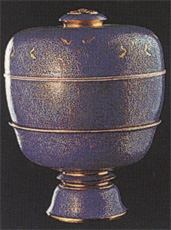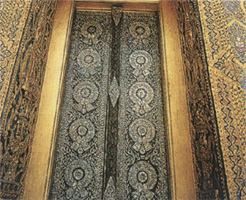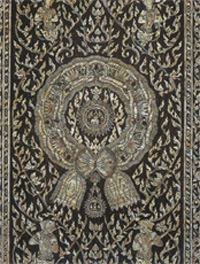|
|
|
The Arts
|
Lacquerware and Mother-of-Pearl Inlay
The art of making lacquer originally
came to Thailand from China, probably
by way of Burma (now Myanmar),
but over the centuries distinctively Thai
designs and techniques were evolved.
It became a notable handicraft in the
northern province of Chiang Mai and
is still made there in a number of households.
 |
Examples of Thai lacquerware, a famous product of the north |
Lacquerware begins with finelywoven bamboo basketry or well-seasoned
wood which has been carved or shaped
on a lathe into the desired shape. To this
is first applied a basic coating material
called sumuk, consisting of the ashes of
burnt rice-paddy husks or ground clay
mixed with rak or black lacquer,
obtained from a tree which grows in the
northern hills. When dry this is polished
with soap-stone and then another coating
is applied. This process is repealed
again and again for up to fifteen times,
building up a rigid base of durable
lacquer. At the end. a final characters are
given with a sandpaper-like leaf called bai-nod.
 |
Examples of Thai lacquerware, a famous product of the north |
The object is then ready for
several coats of pure black lacquer, from
three to six coatings. The final layer is
polished with water and powdered fired
cluy, giving it a glistening shine.
 |
A manuscript chest decorated with gold-and-black lacquer paintings
|
A design is then applied by either
a method called lai kud or one called
lai rot nam. If the object is to be in colour
lai kud is used, while lai rot nam is for
objects with gold designs. At the end of
the process the colour or gold stands out
against a background of glossy black.
The use of mother of pearl to adorn
objects has a long history in Thailand.
Stucco pieces embedded with bits of
shell have been found at monuments
dating back to the Dvaravati period (6th
to 11th centuries A.D.), and some form
of the art may have existed even before
in coastal regions.

Gold-and-black lacquer decorations
|
But these early efforts were crude
compared with the magnificent works
achieved in the late Ayutthaya and early
Bangkok periods, when temple doors
and windows, manuscript boxes, alms
bowls, and numerous other items were
splendidly decorated by the painstaking
process me Thais call khruang muk. The
craft continues to thrive today in the
production of exquisitely detailed
furniture, mirror frames, boxes, and
trays that are the pride of owners both
in Thailand and abroad.
 |
Mother-of-pearl inlay decorations
|
The mother-of-pearl inlay technique involves the patient cutting of me
opalescent muk fai, or flame snail,
indigenous to the Gulf of Thailand, The
outer surface of this shell is removed
with a special knife and the pearly inner
shell is cut into fairly flat pieces, each
about two and a half centimetres long.
Sanded flat, they are glued to wooden
surfaces to form patterns or scenes
and the area in between is filled with lacquer.
| | |
|
|